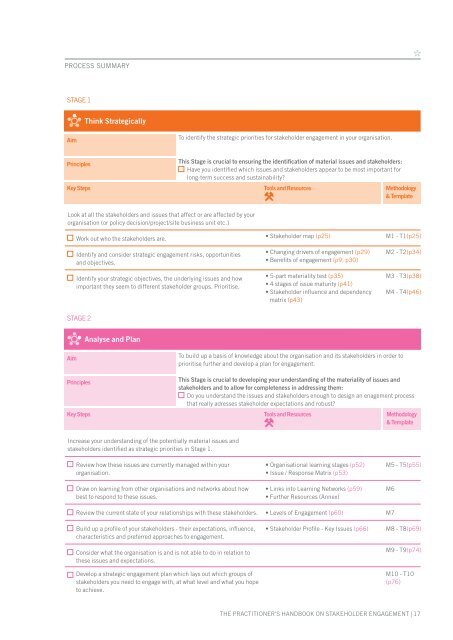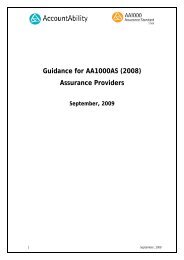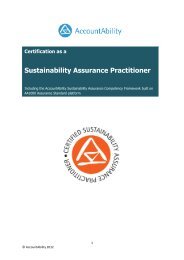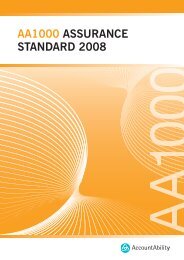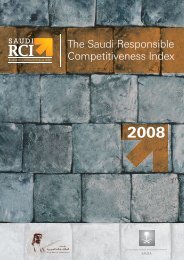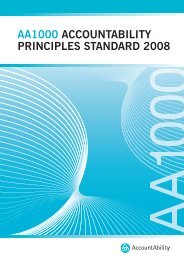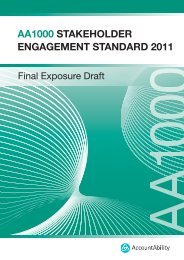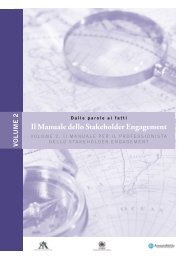The Stakeholder Engagement Manual Volume 2 - AccountAbility
The Stakeholder Engagement Manual Volume 2 - AccountAbility
The Stakeholder Engagement Manual Volume 2 - AccountAbility
Create successful ePaper yourself
Turn your PDF publications into a flip-book with our unique Google optimized e-Paper software.
PROCESS SUMMARY<br />
STAGE 1<br />
Aim<br />
Principles<br />
Think Strategically<br />
Look at all the stakeholders and issues that affect or are affected by your<br />
organisation (or policy decision/project/site business unit etc.)<br />
Work out who the stakeholders are.<br />
Identify and consider strategic engagement risks, opportunities<br />
and objectives.<br />
Identify your strategic objectives, the underlying issues and how<br />
important they seem to different stakeholder groups. Prioritise.<br />
To identify the strategic priorities for stakeholder engagement in your organisation.<br />
This Stage is crucial to ensuring the identifi cation of material issues and stakeholders:<br />
Have you identifi ed which issues and stakeholders appear to be most important for<br />
long-term success and sustainability?<br />
Key Steps Tools and Resources<br />
Methodology<br />
& Template<br />
STAGE 2<br />
Aim<br />
Principles<br />
Analyse and Plan<br />
Increase your understanding of the potentially material issues and<br />
stakeholders identifi ed as strategic priorities in Stage 1.<br />
Review how these issues are currently managed within your<br />
organisation.<br />
Draw on learning from other organisations and networks about how<br />
best to respond to these issues.<br />
Review the current state of your relationships with these stakeholders.<br />
Build up a profi le of your stakeholders - their expectations, infl uence,<br />
characteristics and preferred approaches to engagement.<br />
Consider what the organisation is and is not able to do in relation to<br />
these issues and expectations.<br />
Develop a strategic engagement plan which lays out which groups of<br />
stakeholders you need to engage with, at what level and what you hope<br />
to achieve.<br />
<strong>Stakeholder</strong> map (p25)<br />
Changing drivers of engagement (p29)<br />
Benefi ts of engagement (p9, p30)<br />
5-part materiality test (p35)<br />
4 stages of issue maturity (p41)<br />
<strong>Stakeholder</strong> infl uence and dependency<br />
matrix (p43)<br />
To build up a basis of knowledge about the organisation and its stakeholders in order to<br />
prioritise further and develop a plan for engagement.<br />
M1 - T1(p25)<br />
M2 - T2(p34)<br />
M3 - T3(p38)<br />
M4 - T4(p46)<br />
This Stage is crucial to developing your understanding of the materiality of issues and<br />
stakeholders and to allow for completeness in addressing them:<br />
Do you understand the issues and stakeholders enough to design an enagement process<br />
that really adresses stakeholder expectations and robust?<br />
Key Steps Tools and Resources<br />
Methodology<br />
& Template<br />
Organisational learning stages (p52)<br />
Issue / Response Matrix (p53)<br />
Links into Learning Networks (p59)<br />
Further Resources (Annex)<br />
Levels of <strong>Engagement</strong> (p60)<br />
<strong>Stakeholder</strong> Profi le - Key Issues (p66)<br />
M5 - T5(p55)<br />
M6<br />
M7<br />
M8 - T8(p69)<br />
M9 - T9(p74)<br />
M10 - T10<br />
(p76)<br />
THE PRACTITIONER'S HANDBOOK ON STAKEHOLDER ENGAGEMENT | 17


